Sports Blogging and the Effects of Social Media
This research project was put together in order to understand the world of sports blogging, breaking news and the effect of social media (more specifically, Twitter.) I was fortunate enough to interview four bloggers that range from New York Yankees coverage to New York Knicks coverage. Originally, I was hoping to interview professional journalists and bloggers, however the nature of their blogs along with their on-going news coverage disallowed them from responding to my e-mails. Since both the NBA and the MLB were experiencing more activity than normal (NBA had the All-Star Game in Houston, while the MLB started Spring Training in various locations in Florida and Texas,) the reporters/bloggers on ESPN New York or SNY.TV were unable to be reached for an interview.
That being said, I was able to speak with four bloggers, each with a different viewpoint, a different blogging style, and a different way of coverage. From there, I was able to distinguish the differences in sports reporting along with how Twitter has affected how they have reported news over the past few years.I was fortunate enough to speak with Seth Rosenthal of PostingandToasting.com, Andrew Vazzano of TheRopolitans.com, Lenny Neslin of LennysYankees.com, and Jeremy Schilling of jschil.wordpress.com. Through interview and an in-depth analysis of their respective website, I was able to find some interesting things about the role social media plays in the running of their blogs.
The research will be divided into three parts: 1) background and history of the sites, 2) the results found from my interviews, and 3) a comparison and conclusion. I decided to break it down in those three categories to further understand how each blog works and how the ever-so-changing term of breaking news has attributed to how each blog reports its news.
Background — Posting and Toasting
PostingandToasting.com is a blog that specializes in New York Knicks news. The website takes its name from a former player, Walt “Clyde” Frazier, due to his similar-sounding, synonym-filled, alliterating commentary. PostingandToasting.com is currently a smaller blog, part of a giant, parent website, SB Nation.
SB Nation is the main site that PostingandToasting.com is a part of. SB Nation currently has over 300 blogs that are part of the company. All of SB Nation’s websites have a similar layout to keep its consistency and brand around the sites.
Seth Rosenthal is the current editor of PostingandToasting.com and has been blogging for the site since the 2006-2007 NBA season. The site consists of various sections like “Game Threads, Pre-Game Reconnaissance, and Draft Things” along the usual daily posts of links from various beat reporters around the NBA. Here’s what PostingandToasting.com looks like when you type it into the address bar:
As you can see, the site has a very media-friendly site, using high-resolution photos in the top to attract readers to its content. If there was breaking news, a large, red bar would appear underneath the top bar of links with the title, “BREAKING NEWS: …..” followed by the content. The page also reflects the color of the team that it is reporting for. For example, the blog for the Los Angeles Lakers is filled with links and boxes that are purple and yellow: the team’s colors.
The bottom of the site contains “old” news that readers may want to look back at. They’re sorted in chronological order from newest on top, going down. SB Nation also uses a neat feature found on all of its site called “Story Stream”. “Story Stream” essentially aggregates all of the stories that are related to that one story and puts it in one place so that readers can go to and from a different article at ease, without having to navigate the site for previous reports. For example, if there are reports about a team trying to trade for a player, all of the news will be contained into one location. See the image below for an example:
Posting and Toasting also has various sidebars that is displayed in the home page. The most feature that is relevant to this research is the Twitter feed for the site, @ptknicksblog. The feed displays all of the stories that are posted on the website. For example, the latest story of “Tuesday Post-Practice Updates: Sheed and Camby did some things, Woodson foresees status quo” includes a link that directs you to the page itself: http://t.co/5grVg20f. Of course, in order to fit Twitter’s 140 character limit, PostingandToasting uses a link shortener.
Additionally, Rosenthal will reply back to occasional comments directed at the @ptknicksblog Twitter account, in order to advocate the conversational aspect of Twitter. Rosenthal himself has his own Twitter handle (@seth_rosenthal) where he connects more with fans, while also posting random, humorous tid-bits.
In terms of the other features of PostingandToasting.com, many fans will use two sections on the site called Fanshots and Fanposts. These sections are specially made for fans so that he or she can interact with other fellow PostingandToasting readers. Fanshots is essentially a place where any PostingandToasting member can share images, videos or links that can then be shared or Tweeted by other users. The section of the site encourages interaction, although it is not used as often as other portions of the site.
Meanwhile, Fanposts is a section of the blog where users can submit their own posts that can then be commented by peers. Most of the posts are basketball-related, while there are sections of the Fanposts that seem rather random. Like Fanshots, users can tweet about certain stories and share it on Facebook.
Interview Findings — Seth Rosenthal
In my interviews, I asked bloggers the following questions:
Personal Questions1) Do you consider yourself a journalist? Why or why not?2) How long have you been following and reporting sports news?3) What sites have you’ve been blogging for in the past?4) What is the primary way you access news?5) How often do you check social media outlets for sports news?
Blog Related Questions
1) Do you ever get first-hand accounts/report that put your blog in a position of breaking a story?2) If not, what does it mean to produce a blog that relies entirely on other media sources? Where do you think the added value of your outlet lies?3) Does being the first to report on breaking news matter to the activity of your blog? Or does the activity of your blog matter more on the wittiness and cleverness of your content?4) Do you check your sources on the stories you link? If not, why?5) How much do you rely on Twitter reports in the contents of your blog? How much material on your blog is original content?6) Do you and/or other writers on your blog have a professional code you follow? Why?7) How has Twitter and Facebook changed the way you blog every day?
After receiving the answers back from Seth, I found a lot of the things he told me to be rather interesting. The majority of his blog is different from major sports blogs. What’s interesting to note is that a lot of the SB Nation blogs seem to have a similar feel to how his blog is being run. According to Seth, he feels as if his blogs adds values in a variety of ways that doesn’t require the site to be in position to breaking a story, “I think my value, if I have any, lies in the following: 1. Synthesis, consolidation, and explanation of direct reports, which is particularly relevant in the dense New York market. Like, eight different beat guys report on the same story and I try to make sense of it. 2. Humor. I make jokes. 3. Subjectivity. I’m a fan, and while I try to be even-handed, I write as a fan. I think it makes the product a little less dry, which appeals to some people.”
When I asked Seth the question about how much they rely on Twitter to report its news, he said that he relies on it a lot. He says that he tries to be the first one to “regurgitate and comment on stories in a useful way” while still being witty and thoughtful. In other comments, he states that there are tons of reporters out there who report the same exact thing. How I interpret that is that he’s trying to report the news in a way that isn’t so mundane, boring, and repetitive. Instead, he’s trying to put out news that would capture the attention of witty fans like myself.
Seth posts on his site a daily aggregation of links related to the Knicks. An example can be seen below:
These daily posts are the majority of his usage of Twitter links. What Seth does is gather a bunch of links from (mostly) Twitter and will post it on the site, along with some form of comments. One of Seth’s favorite thing to do is to find something funny or unusual that a beat reporter will tweet, and Seth will comment on it. A perfect example of this would be the Power Ranger tweet that is found in the third image of the section. Also, in order to make the daily posts different, he finds a different animal every day and gives a quick summary about the animal, which is usually humorous and surprisingly informative.
Whenever Seth writes a post-game report, he’ll always have quotes and tweets from beat writers in the bottom of the posts or wherever applicable. He likes to add some sort of tweet that usually updates the fans with a status of a player or even how the team felt after its performance.
I asked Seth a question that dealt with if he follows a professional code. What I found out wasn’t so surprising, but was good to know. Seth says, “There are lines I won’t cross language-wise, but also things I avoid and ask my writers to avoid (wild speculation, obvious link-baiting with no value, etc.) because they bother me.” So he doesn’t have a code specifically for him and his reporters, but I think it’s obvious that there are common sense “codes” that he feels that every writer should follow.
Background — TheRopolitans
TheRopolitans.com is a website that is currently run by a friend of mine, Andrew Vazzano. The site used to be the primary source for many Mets fans during the rise of Twitter, but its primary purpose nowadays is to serve as a forum for Andrew to provide commentary on larger Mets stories. The term TheRopolitans comes from the full name of the New York Mets baseball team, The New York Metropolitans.
Andrew started the blog in early 2006 and has owned the domain since then. He posts mostly larger Mets news, such as big rumors, free agent signings, trades, or any important Mets-related news. He is more active on his Twitter account @TheRopolitans and will tweet about any and all major sporting events that are MLB, NBA, NFL, or NHL-related.
Here is what TheRopolitans.com looks like today:
The website features a traditional two-column blog layout. He features his Twitter feed on the right hand side of the page as well as a basic search bar for his website. One of Andrew’s favorite feature for many of his stories is to use Storify, which is an aggregation application that allows users to combine replies or hashtags about a certain subject that creates a story about the initial question or response. Storify is used by many media outlets and is also used by many pop culture websites. You can the beginning of his Storify story towards the bottom of the added screenshot.
Interview Findings — Andrew Vazzano
I asked the same questions that Seth received and the answers aren’t too different. Andrew’s biggest thing he likes to stress is that being a sports blogger is extremely difficult nowadays. The only way to be effective in the land where sports bloggers are over-saturating Twitter is to be unique, “A lot of people ask me about blogging tips and I always say: Write about what you love. Don’t try to be anyone else. Find your niche and go crazy with that.”
When I asked Andrew about social media usage, one of the things he likes to do is use a platform like Storify to highlight fans voices, “Almost all of my blog is original content, but one of the cool things I think I do is help feature other fans voices. Usually, I’ll ask a question on Twitter and pull in fans responses to help flesh out an article or use that as a standalone piece. Everyone wants to see their name in lights but not everyone has time to blog, so I take a quick thing like Twitter and create content for my site.”
As stated earlier in the background, Twitter not only is a form of reporting news from beat writers and other professionals, but its also a way to create stories from other fans. Fans love getting the attention from popular bloggers and writers, so it helps to create traffic for a website if someone uses their own words in the website’s story. Additionally, Twitter is one of the top ways for people to be known, while also getting news.
Background — Lenny’s Yankees
Lenny’s Yankees is a New York Yankees blog that was created in the early days of 2009. On January 20, of that year, Lenny Neslin started blogging about his favorite baseball team after graduating with a journalism degree from Quinnipiac University. Lenny’s Yankees is the home of originally curated content from Lenny himself, posting opinionated articles and commentary on news reported by other journalists and bloggers. Lenny has posted less frequently over the past few months, but when he used to posts daily, he would interact with readers by asking questions that would be used as talking points.
Here is a screenshot of Lenny’s Yankees today:
As you can see from the homepage, the layout and color reflects the primary colors of the New York Yankees. He uses a traditional three-column layout with sidebars that display other sports blogs, advertisements and social media outputs. Social media is big on Lenny’s Yankees as well, as the social media sidebar is highlighted with large icons that corresponds to the website that it displays. Additionally, each story that is posted on the blog contains a “Bookmark & Share” button that allows readers to use web services such as delicio.us to save the story or Twitter to tweet about the story. Aside from the basic features, the rest of the website does not contain as much interaction that can be found on PostingandToasting.
Interview Findings — Lenny Neslin
When speaking with Lenny, I was intrigued to find out that he was once an online sports editor for the New York Daily News, one of the major newspapers in New York City. When I asked him if he considered a journalist because of that, he gave me a rather interesting answer, “[W]hen I blogged multiple times per day, I didn’t consider myself a journalist. I called myself a blogger. I consider bloggers as the next level below journalists, sort of an extension to journalism.” Despite being connected with the Daily News, he felt as if it was his job to be a blogger and “curate the best content from the Yankees beat writers and then provide my analysis.”
He continued on by giving beat writers the proper credit since he says, “The beat writers are the ones doing the real journalism work — conducting interviews regularly, breaking news stories, etc.” What makes this comment important is the fact that he feels as if bloggers have a duty to do something else than just report the news. Even though there are many similar blogs out there, reporting the news shouldn’t be the primary job of the bloggers. Why? Because that’s the reason why there are beat reporters who are paid to do what they do. According to Neslin, they’re the ones that are providing bloggers with things to talk about.
Unlike Seth, Neslin feels as if wittiness, cleverness and timeliness doesn’t drive traffic to his site. Rather, Neslin says, “[B]eing controversial is a more important characteristic on an aggregation and analysis blog like mine. Being first is great too, but almost never happens. That’s what the beats are for.”
Why be controversial? Well, from a fan’s perspective, it’s a great way to start a conversation. As you can see from this post, the comments that were posted was being of Lenny’s “unwritten rules of baseball”:
When I asked Neslin about Twitter usage, he reiterates what he mentioned earlier, “Beat writers use Twitter to report things. All of my content is original, but not original reporting.” He adds that his blog is essentially a curation of stories along with analysis, but like how Seth blogs, and similar to how Andrew blogs.
Background — J Schil’s Blog
From the looks of it, J Schil’s Blog looks like any amateur sports blog. Jeremy Schilling runs and operates the blog himself and posts predominantly about golf. However, over the years, Schilling has posted about the MLB, the NBA, and the NFL, specifically about the New York Jets.
Jeremy uses a WordPress design, that is simple and easy to read. Check below to see how his golf-infused blog looks:
Schilling blogs in an approach different from the rest of the bloggers that were mentioned earlier. Instead of focusing on linking to other articles and providing commentary, Schilling will instead create his own content that doesn’t incite any form of conversation. His way of blogging is just posting whatever is on his mind. His primary use of the site is to post anything related to sports. That being said, Schilling will post articles and provide some form of commentary. However, he doesn’t do this method as much as other bloggers have.
Interview Findings — Jeremy Schilling
Jeremy brings a different perspective when I interviewed him, “I’m in a different boat because I am both a journalist and not a journalist. Covering Monmouth University football, I’m strictly a journalist (especially on game stories), yet when I write columns for RotoWire or NewJerseyNewsroom.com or my own site (which is mostly a blog), I, sometimes subtly, insert my opinion in places.”
Since Schilling is trained to be a journalist, it’s interesting to see that he uses his WordPress blog to express his opinions on specific sports items without the boundaries that are found in a journalistic organization. And because he writes for himself in his own blog, the answer I got back when I asked him about breaking news was similar to others, “When I blog, especially about breaking news, I usually quote other people’s articles and give my opinion below that. Occasionally I’ll do some reporting myself on it but most times I’m posting quotes from the general article.”
An example can be seen here:
When the Chicago Cubs suspended a player, Milton Bradley, it was widely reported around the entire league. Since it was a breaking story, Schilling quoted the organization while also providing an opinion on the entire situation.
In terms of the other questions that I asked, Schilling had a similar opinion, much like the other bloggers. Twitter plays a huge role for Schilling, “Twitter is a huge part of what I blog about in terms of finding news stories, but I do post some original content — like my fantasy picks or golf television theme music — so that stuff doesn’t come from Twitter. So, lately, while I’ve been blogging less, it’s about half-and-half.”
And just like the rest of the bloggers, being first in reporting news isn’t a priority, “I’ll post an update if the story requires it, but it’s not for me a competition for who gets the story first.”
Comparison and Other Studies
So with the interviews completed, what did I find about the effects of social media on sports blogging?
Well, first things first: Sports blogging has gone through numerous changes over the past few years due to the rise of Twitter. As Seth and Andrew pointed out, sports blogging is not about being the first person to report the news anymore. Because Twitter was so new in the late 2000s, no one expected to get news from Twitter. It was not until the breakthrough of Twitter in the early 2010s that really shifted the way people got their breaking news from.
Andrew brings up a interesting point about blogging nowadays, “Write about what you love. Don’t try to be anyone else. Find your niche and go crazy with that.” As I said before, there are tons and tons of blogs dedicated to sports on the Internet today. You’re guaranteed to see the same story posted multiple times, especially if it refers to a free agent signing, a major trade or even just a rumor. Many blogs will report the news and act as if they’re the primary source of information that people will go to. However, that’s not the case.
Experienced bloggers like Seth, Andrew, Lenny and Jeremy all understand that journalists, news organizations and beat reporters have Twitter accounts that are used to break news. It’s not their (Seth, Andrew, Lenny and Jeremy) duties to break news that beat reporters from various news organizations have posted, simply because they know people already follow them. As Seth said in his interview, you’ll find many people reporting the same thing, which can get monotonous and mundane.
The reason why experienced bloggers continue to get readers is because they’re doing something that others aren’t doing. Either by being witty, controversial or even by creating stories that include the public, they’re finding ways to keep sports blogging fresh. If everyone in the Internet “broke news” then when does it lose its title of being “breaking news?”
Simply stated, these blogs don’t break news. They collect stories that include breaking news and create new content that readers will find and share. Blogs aren’t used to break news anymore. That’s what Twitter is for.
A study performed by Kwak et al. (2010), showed that Twitter has slowly transformed from a primary social network to a form of news media. The study cites that the popularity of news organizations in the Top 20 Most Popular Twitter Users along with the number of retweets that mainstream news media receive attributes to it being a news organization. Additionally, the study says that breaking news sometimes beats even the most popular of mainstream media, “However, some news broke out on Twitter before CNN and they are of live broadcasting nature.”
What the study shows is exactly what the bloggers mentioned in the interviews. Twitter is the focal point for breaking news, which leads to why they blog in the manner that they do. Because more people flock to Twitter for the most updated news, it’s easier for bloggers to aggregate all of the links and tweets that beat reporters release in order for them to create a cohesive story.
Another study performed by Zhao et al. (2011), seemingly confirms the findings of the Kwak et al. study. One of the findings from the Zhao study showed that retweeting event topics helps spread important and breaking news. Since there has been a rise of news organizations reporting news and breaking news on Twitter, the reason it spreads is because of all of the followers who also “report” the news too. This is related to the coverage of breaking news in sports because by using Twitter, fans of sports teams can just see a news report being retweeted by a fellow fan instead of having to go to their favorite sports blog.
And finally, in his book, “Here Comes Everybody,” Clay Shirky brings up the idea that people today are living in such a populated time in terms of media tools, “we are living in the middle of a huge increase in the number of available tools: the launch of Twitter, the text-messaging tool, happened during the writing of this book.” What does that mean for sports blogging?
Well, in hindsight, everyone has the possibility of reporting “news” in seconds. Those people also has the chance to blog at any time in any place. But that also means that the airwaves get flooded with the same thing, like what Seth and Andrew mentioned during their interview. By removing the breaking news reporting from people’s blog, the more you give beat writers and reporters a chance on getting their official word out.
Conclusion
In conclusion, sports blogging and social media are both best friends and enemies. If used correctly, each side can benefit from the proper use of it. However, if too many bloggers say the same thing or if too many users on Twitter tweet the same thing, you’re allowing for the over-saturation of users’ timeline. Seth Rosenthal, Andrew Vazzano, Lenny Neslin and Jeremy Schilling all use their blogs in a manner than isn’t congesting to the every day reader.
It’s a manner that allows readers to be enthralled by their opinions, but also allows them to read up on important news stories without the repetitiveness that can be found on a quick glance at their Twitter timeline. Social media is important to all of these bloggers and it is essentially in the way that they do blog. The way they use social media shows that the general public today has clearly taken a side on who should report breaking news: Twitter.
- Shirky, Clay. Here Comes Everybody. New York: Penguin, 2008. Print.
- Zhao, Wayne, et al. “Comparing twitter and traditional media using topic models.” Advances in Information Retrieval (2011): 338-349.
- Kwak, Haewoon, et al. “What is Twitter, a social network or a news media?.”Proceedings of the 19th international conference on World wide web. ACM, 2010.
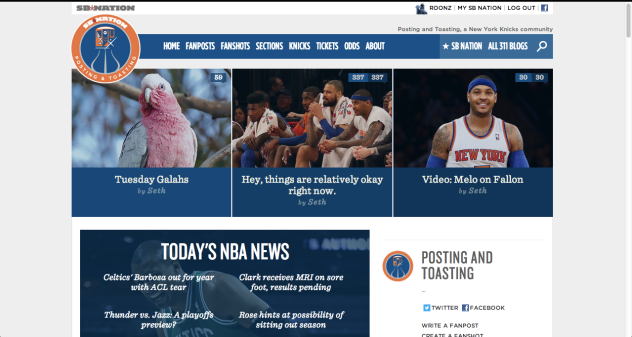

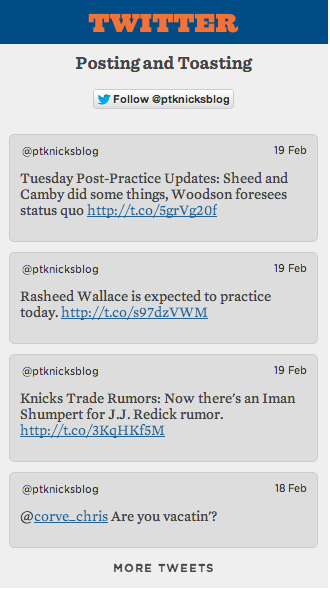
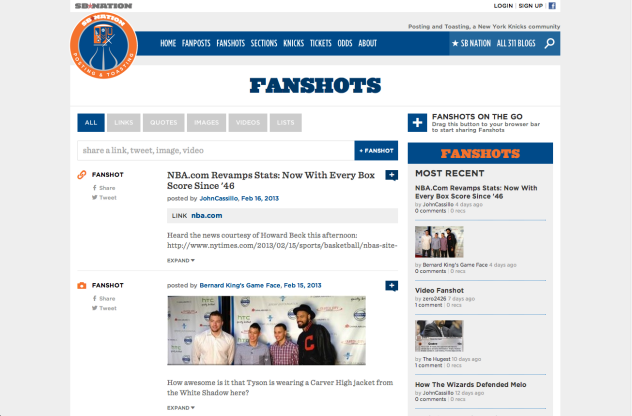
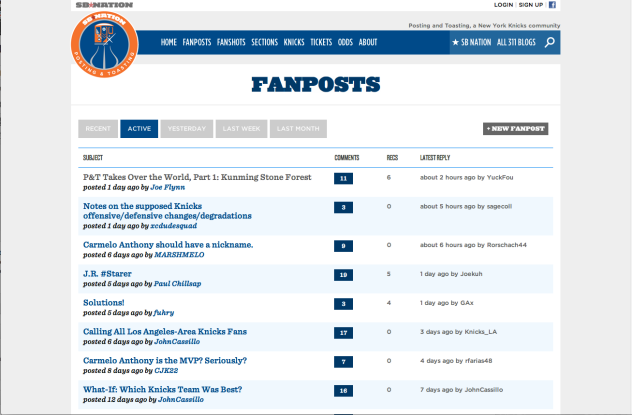

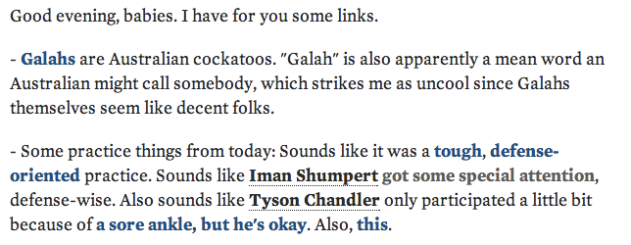
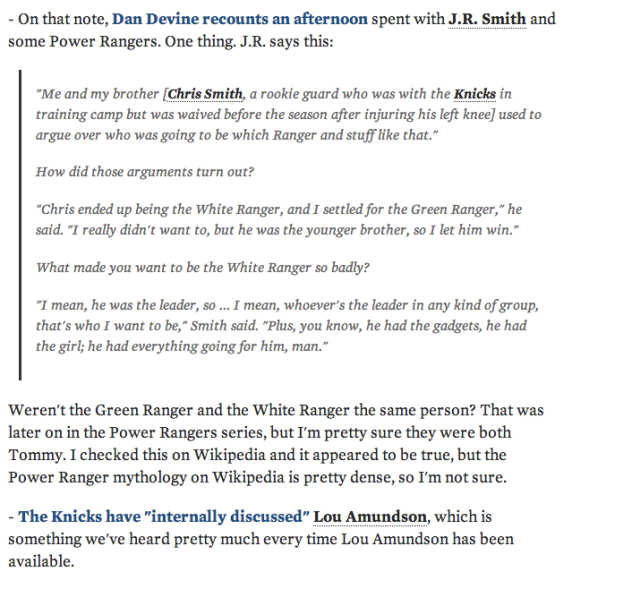
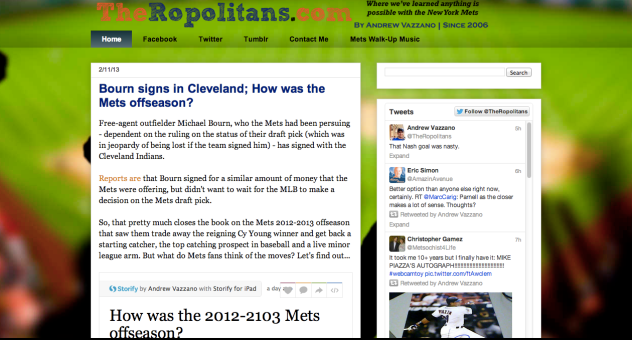
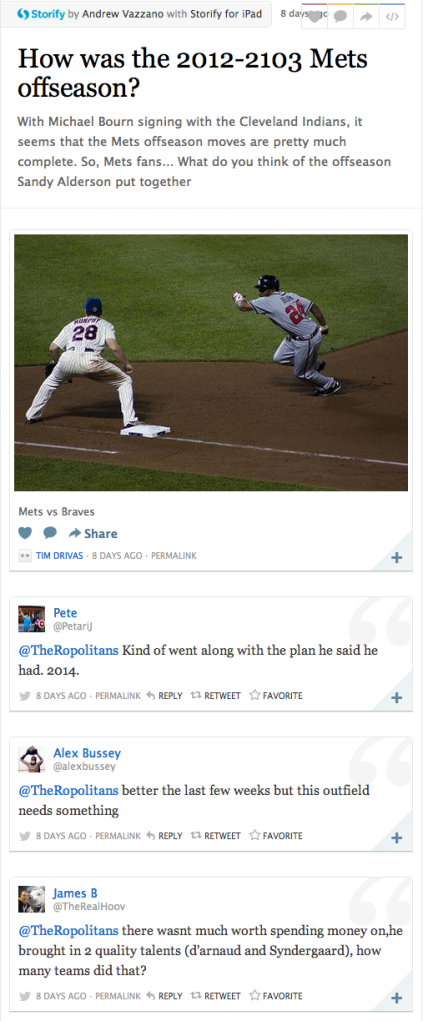

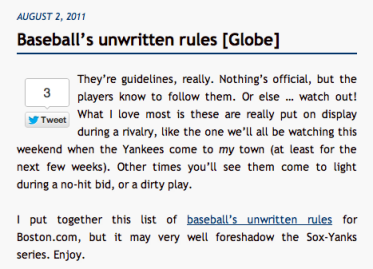
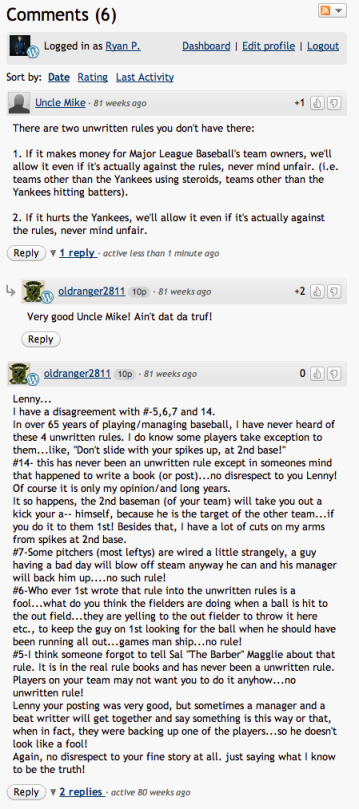
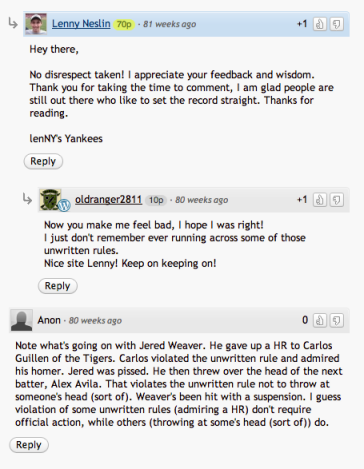
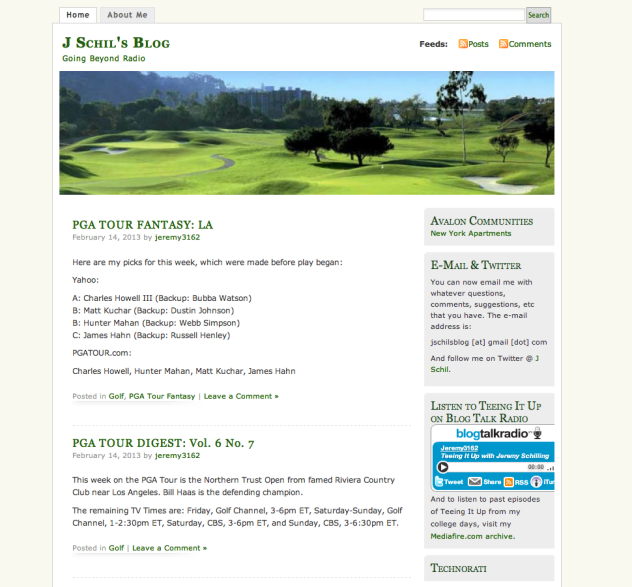
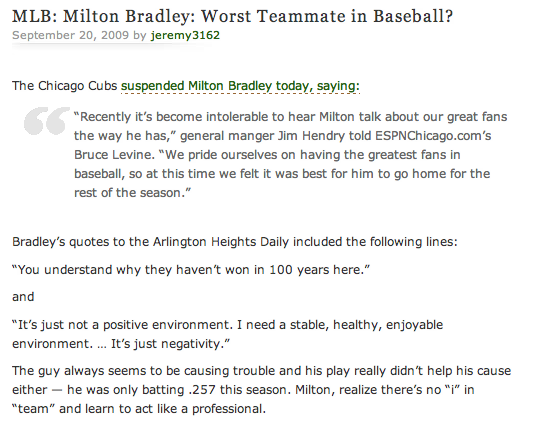
mdeseriis 10:58 am on February 26, 2013 Permalink |
Ryan, thank you for writing this very clear, well-researched and thoughtful travelogue. It is unfortunate that the more professional writers did not get back to you but it is understandable given the moment.
As for the bloggers you interviewed, I would say that their answers are not surprising at all. In your conclusion, you write “blogs aren’t used to break news anymore.” But was it ever the case? The primary function of blogs has never been to break news or investigative reporting. There are exceptions of course–i.e., occasionally well-connected bloggers (usually former industry insiders) get access to information and stories that no one else has. But by and large bloggers do precisely what your interviewees say they do. They access sources where everyone else can find them (mostly Twitter nowadays), sort them, and compile them in a narrative form so that readers can make sense of what is going on without having to go and check every Twitter feed.
On top of that, these bloggers interject their subjectivity in their writing style. Since these blogs are not about breaking news, their value lies almost exclusively in the perspective they add to a given phenomenon. In this respect, it is no surprise that some of these bloggers define themselves as fans who speak primarily to other fans. (We might even call it a subculture.) All of this is to say that while your travelogue is very well-researched and developed, the conclusion does not really surprise me.